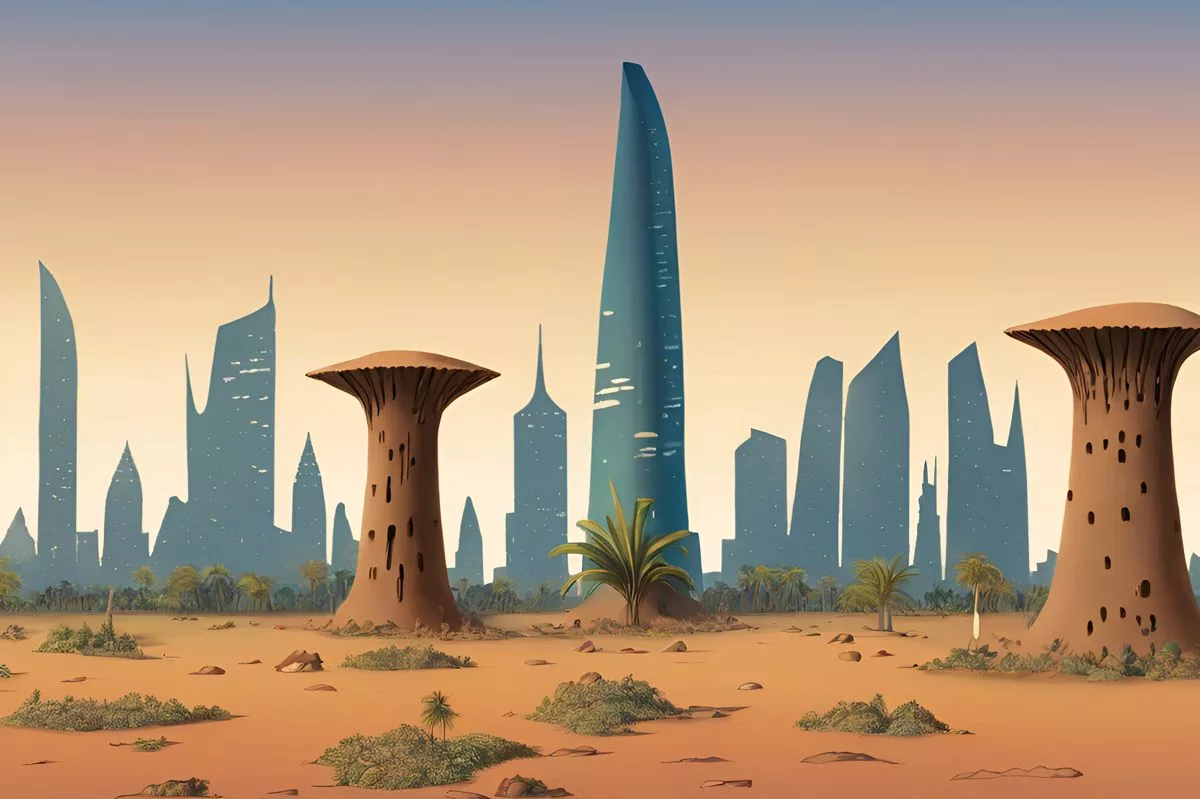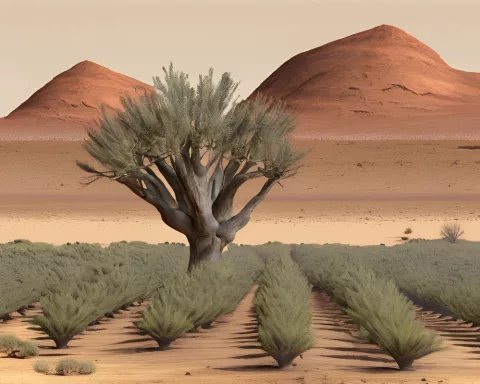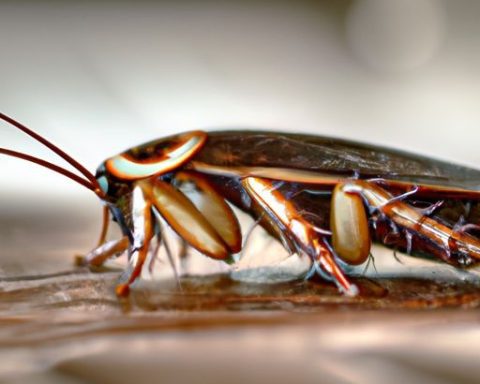The termite mounds of Namaqualand, South Africa, have been found to be the world’s oldest termite colonies, dating back 34,000 years. These heuweltjies have provided crucial insights into ancient climates, ecosystems, and carbon sequestration processes, making them important for calculating a country’s carbon budget and combating climate change. The termites’ harvesting activities and the dissolution of soil mineral calcite in these calcareous mounds offer long-term carbon storage solutions that companies strive to replicate in enhanced weathering and ocean alkalinity enhancement projects. These termite mounds are a natural wonder that provides a glimpse into Earth’s ancient past.
Unearthing History: The Ancient Termite Mounds of Namaqualand. These mounds are the sites of the world’s oldest recognized termite colonies, some of which trace back an impressive 34,000 years, providing crucial knowledge about ancient climates, ecosystems, and carbon sequestration processes. The heuweltjies act as physical records of prehistoric climatic conditions and facilitate two methods for sequestering CO2, offering a long-term carbon storage solution that several companies strive to replicate in enhanced weathering and ocean alkalinity enhancement projects. These processes are vital for calculating a country’s carbon budget, as outlined in the Paris Agreement, and during land-use transformations.
A Glimpse into Earth’s Ancient Past
In the stark, dry landscape of Namaqualand, adjacent to South Africa’s Buffels River, researchers have made a striking revelation regarding the planet’s antiquity. This terrain is dotted with myriad peculiar earth mounds, locally referred to as “heuweltjies” or “little hills” in Afrikaans. These mounds are the sites of the world’s oldest recognized termite colonies. Some of these mounds trace back an impressive 34,000 years, serving not only as historical residences but also as living records, providing crucial knowledge about ancient climates, ecosystems, and carbon sequestration processes.
The architects behind the heuweltjies are the southern harvester termites, known scientifically as Microhodotermes viator. This species has endured through ages, outliving species like the woolly mammoths and surviving the chilling extremes of the Last Glacial Maximum. Dr. Michele Francis, a Senior Lecturer in the Department of Soil Science at Stellenbosch University, states that these termite colonies were already aged when massive ice sheets covered vast tracts of the northern hemisphere roughly 20,000 years ago.
To truly appreciate the antiquity of these termite colonies, one needs to comprehend that they existed before the renowned cave paintings in Europe. They were flourishing insect metropolises during the Last Glacial Maximum. These termite mounds, older than any found earlier, are akin to living relics, embodying a substantial segment of Earth’s history.
Radiocarbon Dating and Historical Climates
Radiocarbon dating of the organic carbon in the mounds revealed ages fluctuating between 13,000 and 19,000 years. Simultaneously, the carbonate traces its origin back to about 34,000 years. This makes the Buffels River mounds the most ancient active termite colonies discovered so far, housing both organic and inorganic carbon. Previously, the Brazilian mounds, home to a different termite species, held the record for the oldest inhabited mounds at a comparatively junior 4,000 years.
However, the heuweltjies don’t merely stand as a symbol of termite resilience and architectural competence. They also act as physical records of prehistoric climatic conditions. The mere existence of the mounds suggests a time when this region received significantly more rainfall than it currently does, causing minerals such as calcite and gypsum to dissolve and seep into the groundwater, a process that impacts our understanding of natural carbon sequestration.
Carbon Sequestration and Climate Change
The heuweltjies facilitate two methods for sequestering CO2. Firstly, the termites’ harvesting activities introduce newer organic material deep into their nests, continually refreshing crucial soil carbon reserves. This activity prolongs the lifespan of these reserves, compared to those located on the surface. Secondly, the dissolution of soil mineral calcite in these calcareous mounds can sequester CO2, offering a long-term carbon storage solution that several companies strive to replicate in enhanced weathering and ocean alkalinity enhancement projects.
These processes are vital for calculating a country’s carbon budget, as outlined in the Paris Agreement, and during land-use transformations. Consequently, the heuweltjies play a critical role in combatting climate change. By harnessing nature’s carbon sequestration techniques, we may discover sustainable solutions to our ongoing environmental plight.
A Natural Wonder Spanning Millennia
These termite mounds are a tangible link to Earth’s history, and the discovery of these structures has been compared to deciphering an ancient manuscript that challenges our comprehension of the past. Dr. Francis contends that their age and the insights they provide about ancient ecosystems should earn these mounds worldwide recognition as a natural wonder.
The termite mounds in Namaqualand present an awe-inspiring testament to the complex interactions between life, climate, and environment over tens of thousands of years. They highlight the intricate balance of survival and adaptation, and the resourcefulness of the diminutive engineers that have inconspicuously been shaping our world for millennia.
A team from Stellenbosch University’s Departments of Soil Science and Earth Sciences, assisted by experts from Hungary’s Institute for Nuclear Research, spearheads the exploration of these ancient mounds. A doctoral student at Stellenbosch University is further studying the heuweltjies as part of a joint US-South Africa research collaboration, aiming to gain a deeper understanding of their carbon storage potential.
In Namaqualand’s heuweltjies, we witness Earth’s extensive history, the significant resilience of life, and the relentless work of numerous generations of tiny termites. These mounds are more than just historical monuments; they are living, thriving ecosystems that continue to shape our world and might hold the solution to one of our biggest challenges: climate change.
How old are the termite mounds in Namaqualand, South Africa?
The termite mounds in Namaqualand, South Africa, are the world’s oldest recognized termite colonies, dating back 34,000 years.
What insights do the termite mounds provide?
The termite mounds in Namaqualand provide crucial insights into ancient climates, ecosystems, and carbon sequestration processes.
What is the significance of the termites’ harvesting activities and the dissolution of soil mineral calcite in these calcareous mounds?
The termites’ harvesting activities and the dissolution of soil mineral calcite in these calcareous mounds offer long-term carbon storage solutions that companies strive to replicate in enhanced weathering and ocean alkalinity enhancement projects.
How do the termite mounds contribute to combating climate change?
The heuweltjies facilitate two methods for sequestering CO2, making them vital for calculating a country’s carbon budget, as outlined in the Paris Agreement, and during land-use transformations. By harnessing nature’s carbon sequestration techniques, we may discover sustainable solutions to our ongoing environmental plight.
What is the significance of the mounds in Namaqualand?
The termite mounds in Namaqualand are a natural wonder that provides a glimpse into Earth’s ancient past. They are a tangible link to Earth’s history that challenges our comprehension of the past and should earn worldwide recognition as a natural wonder.
Who is spearheading the exploration of the ancient mounds?
A team from Stellenbosch University’s Departments of Soil Science and Earth Sciences, assisted by experts from Hungary’s Institute for Nuclear Research, is spearheading the exploration of these ancient mounds.










